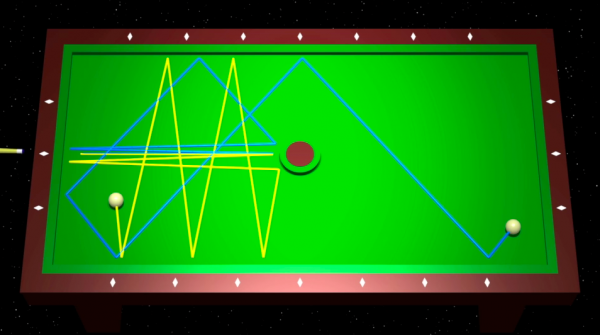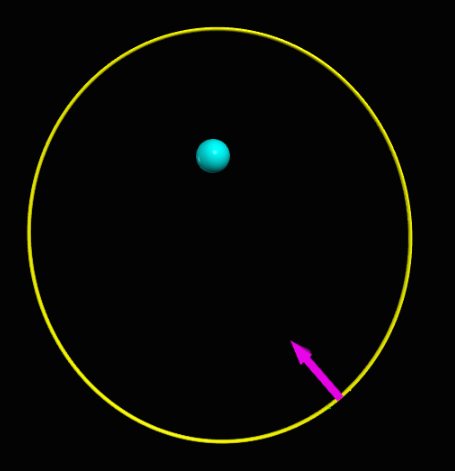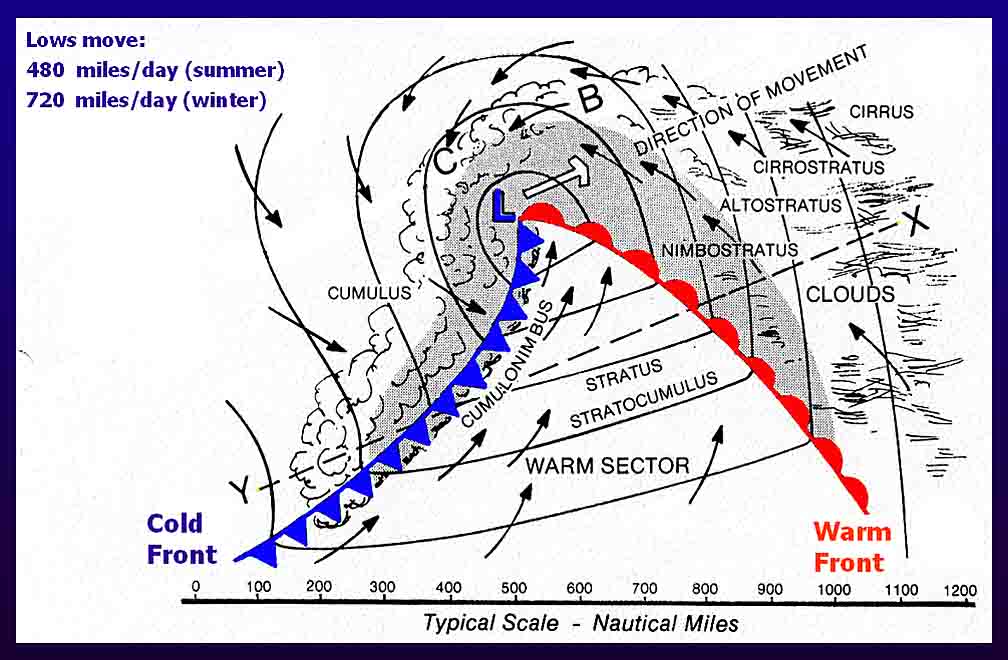Determinism: Difference between revisions
| Line 32: | Line 32: | ||
In Physics 1, you will often use VPython to model the future behavior of systems given a set of initial conditions. The steps to do this, with given time step (deltat), initial momentum (p_initial), and initial position (pos_intiial) are: | In Physics 1, you will often use VPython to model the future behavior of systems given a set of initial conditions. The steps to do this, with given time step (deltat), initial momentum (p_initial), and initial position (pos_intiial) are: | ||
#Calculate the net force on the object. <br> [[File:Glowscript2.png|frame|right| | #Calculate the net force on the object. <br> [[File:Glowscript2.png|frame|right|155x200px|Screenshot of Glowscript program]] | ||
#Calculate the change in momentum (deltap) of the object using deltap = Fnet*deltat. <br> | #Calculate the change in momentum (deltap) of the object using deltap = Fnet*deltat. <br> | ||
#Calculate the final momentum using p_initial + deltap = p_final. <br> | #Calculate the final momentum using p_initial + deltap = p_final. <br> | ||
Revision as of 00:26, 3 December 2015
By Areeba Abid
Determinism is the idea that if the physical state of a system is known, including the momentums, positions, and forces of each object in the system, the behavior of the system can be calculated using iterative prediction to determine its behavior at any given time. This idea is based on the Momentum Principle, developed by Isaac Newton.
Concept and Limitations
Physical and Philosophical Determinism
Newton's laws allow us to predict the motion of an object if we know the initial position, initial momentum, and forces acting on the object. Using iterative prediction, we should be able to calculate where the object will be at any given time in the future. If this idea is extrapolated to all objects in the universe, it would seem that we could predict the future of the entire universe if we only knew the initial conditions (the starting positions and momentums, and forces being applied) of each object. From a scientific standpoint, this means that the future state of the universe should theoretically be able to be determined by scientists using simple physics. This idea has been taken even further in a philosophical context to argue that humans do not have free will, because the atoms that make up our bodies simply continue to move in the paths we would expect based on their initial conditions.
Practical Limitations
While the idea of determinism seems straightforward at first, there are actually complicated reasons that we cannot precisely predict the future of small, simple systems, much less the entire universe.
One practical limitation is the fact that initial conditions can only be measured as accurately as our instruments allow, and after a few time steps, small inaccuracies build on each other. This means that over time, our model of the system and our predictions of its future state stray farther and farther away from the actual future state of the system. This is why iterative prediction is usually only used over small periods of time.

Another practical limitation is that we must necessarily simplify systems to be able to model them. It is impossible to account for every interaction within and outside a system, since every particle in the universe interacts with every other particle in the universe, resulting in an unthinkable number of calculations that would need to be done to accurately account for the net forces on a system. This introduces error that limits the long term accuracy of any calculations we can carry out.
Furthermore, Newton's laws are not always sufficient. For systems with small particles, quantum mechanics comes into play. If gravitational interaction between massive objects is involved, the Relativity needs to be taken into account. Additionally, the Heisenberg Uncertainty Principle asserts that we physically cannot know the position and velocity of a particle with one hundred percent certainty, which limits the precision of our calculations.
Chaos
Determinism and chaos are related, almost opposite concepts. Chaos results in systems that are extremely sensitive to initial conditions. Tiny changes in initial conditions quickly lead to dramatic differences in behavior. Any system that exhibits chaos presents a challenge to deterministic theory because the future behavior of a system is so difficult to predict and varies wildly based on miniscule, imperceptible differences in initial conditions, demonstrating in an extreme way the practical limitations that hinder deterministic calculations.
Modeling

Mathematical Model
For an understanding of the mathematical equations relevant to determinism, see Iterative Prediction.
VPython Model
Basic systems can be considered deterministic and calculated with some level of accuracy. In Physics 1, you will often use VPython to model the future behavior of systems given a set of initial conditions. The steps to do this, with given time step (deltat), initial momentum (p_initial), and initial position (pos_intiial) are:
- Calculate the net force on the object.

Screenshot of Glowscript program - Calculate the change in momentum (deltap) of the object using deltap = Fnet*deltat.
- Calculate the final momentum using p_initial + deltap = p_final.
- Calculate final velocity (v_final) by dividing final momentum by mass.
- Calculate change in position (deltapos) using v_final*deltat = deltapos.
- Calculate final position (pos_final) using pos_initial + deltapos = pos_final.
These steps should be repeated using a while loop.
Sample Glowscript Code
Sample Glowscript code and a basic program can be found here.
Example: Weather Systems

For a practical example of a system that should theoretically be deterministic, consider the weather. Meteorologists use the movement of weather fronts to predict the weather in the near future, and if the temperatures and velocities of masses of air were known with precision, they should be able to determine what the weather will look like in the next few days. However, we all know how inaccurate weather predictions can be just a couple days in advance. This is because of the difficulty of measuring atmospheric conditions with the level of precision required for iterative prediction.
Connectedness
Connection to Personal Interest: Philosophical Determinism
How is this topic connected to something that you are interested in?
Determinism has fascinating implications for the concept of free will. Even if it is impossible for us to calculate the future behavior of a system accurately, it is still without a doubt the direct result of the initial conditions, as directed by Newton's laws. Consider the human body as a physical system. If the body is simply a collection of particles and thoughts in the brain are just neurons firing, is every feeling experienced and every decision made by a person simply the result of whatever initial conditions they started with? Is it possible to differentiate between the laws that regulate matter and the laws that regulate our own bodies? What happens when we try to apply the laws of physics to the workings of our minds? It's difficult to think of your body as a collection of chemicals that behave like a very complicated deterministic system, but the implications are mind blowing and have been the subject of controversy since ancient times.
Connection to Major: Engineering Applications
How is it connected to your major (biomedical engineering)?
Predicting the behavior of physical systems is important for any engineer, and determinism makes this possible to some extent.
Connection to Industry: Ethernet Data Transfer
Is there an interesting industrial application?
Data transmission takes time, and knowing the time that it takes for information to travel from one location to another is important is some industrial applications, such as sending control variables to a high-speed CNC mill. Engineers need to be able to know how long it will take for a machine to receive data, and if a system is deterministic this can be calculated. However, Ethernet systems are not deterministic and the rate of data transfer is unpredictable, which poses problems for engineers. Source
History
The concept of determinism has been around for centuries and was explored by thinkers around the world. Physical determinism was bolstered by Newton's Laws, and the first publication discussing it in a scientific context, "LaPlace's demon", was written by Pierre Laplace in 1814. He wrote that a hypothetical omniscient observer could potentially predict the entire future of the universe. Even though this is practically impossible for any human or computer to ever achieve, LaPlace argued that it was still hypothetically possible if physical determinism were true. However, this was before 1927. when the Heisenberg Uncertainty Principle asserted that initial conditions cannot be known with complete accuracy, even hypothetically.
See also
Background Physics
Fundamental Interactions
Khan Academy: Heisenberg Uncertainty Principle
General Information on Determinism
Determinism
Physical Determinism
More on Free Will
Khan Academy/MIT: The Problem of Free Will
Video Arguing Free Will Doesn't Exist
Video Arguing Free Will Does Exist (Sort Of)